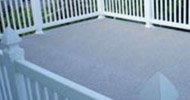Installing Decking Material - Start From the Perimeter
To get the best finished look start installing decking boards or composite material from the outside edge of the deck first.
This way you can account for the ¾” fascia board and a 1” overhang as well as the notching around the railing posts.
 |
Use a sliding bevel to determine the angle of the railing posts against the deck boards. Then transfer that angle to the deck board, measure the width of the post, and trace the other cutting line. The best advice here is “Measure Twice, Cut Once”. But when you are done you will have achieved a very nice finish. |
Allow for Sufficient Overhang of Decking
When installing decking boards, be sure to allow for enough overhang to cover the fascia board and whatever additional amount you prefer. A one to two inch overhang beyond the outer fascia board is sufficient.
This means the installed deck boards should have at least 1.75 to 2.75” overhang before the fascia is installed.
Ensuring Decking is Parallel
Start by installing the first deck board on the front outside edge of the deck framing. Ensure an equal overhang along the length of the board and nail or screw it in place.
Continue with each board working your way to the house and using a spacer, such as a nail, to keep the gap uniform.
Many boards have a slight curve to them so pry the boards in line and parallel by using a chisel into one of the joists and levering the board closer to the other.
Or use this deck lever tool to straighten it up in a snap. It will save you dulling up your chisel and it’s designed perfectly to do this job.
Nailing or Screwing Decking
If you use a soft wood, nails will work fine. Use at least a 3” nail and preferably spiral galvanized for a stronger hold.
However, with cedar and a 3.5” board it is possible to use a galvanized finishing nail without the spirals. Cedar is a softer wood and a narrower board has less pulling power in the event that it tries to cup upwards.
If you are using a pressure treated lumber as the decking material, definitely use a 3.5” spiral galvanized nail.
Pressure treated lumber is known to cup, crack and has a lot of pulling power. In fact, it will likely loosen the spiral nails over time. Screws are your best option.
Installing decking with screws is the best but is also more expensive. But they are your best bet especially with pressure treated lumber.
Set the nails or screws below the deck surface. If using nails, tap the nail flush then use a nail set to drive it below. If you mark the wood with the hammer, such as cedar, apply a little water and it should help the hammer dent lift up.
You can fill the holes with external wood filler but they will be visible unless you stain with a solid color. Even then they will still be visible to a degree.
An excellent durable filler is auto body filler. But it is usually white in color, unless you can tint it. It is very hard and the least likely to pop out over time. It also sands very well. It would be a good solution if you are planning on staining with a solid color.
Gaps Between Decking Boards
Almost all decking lumber is wet when it is installed and will shrink as it dries out. It is not uncommon for a 6” wide board to shrink ¼”. This translates to as much as 1/8” on either side of the board.

Keep this in mind when you are installing decking boards and the gaps. Using ¼” gaps between wet boards is too much. This ¼” gap will soon grow to about ½” once the lumber dries out.
A nice spacing for wet lumber is about 1/8” or the diameter of a 3” galvanized finishing nail. Use the nail as a spacer when you torque the boards in close.
If the lumber is dry the gaps will stay at 1/8” and if they expand with rain there is still sufficient room to allow for that expansion. But most importantly, a slight gap allows water to escape and not pool.
Now that your questions about installing decking boards have been answered and you have installed the fascia board, you are ready to start building stairs.
Home > Building A Deck > Installing Decking


























